New Generation Currency Series
The New Generation Currency (NGC) Series is the name used to refer to Philippine peso banknotes issued since 2010 and coins issued since 2018 (2017 for the five peso coin).[1] The series uses the Myriad and Twentieth Century typefaces.
| New Generation Currency Series | |
|---|---|
| Piso ng Pilipinas (Filipino) | |
| Demographics | |
| User(s) | |
History of the Banknotes
Background
In 2009, the Bangko Sentral ng Pilipinas announced that it will launch a massive redesign for its banknotes and coins to further enhance security features and to improve durability.[2]
Introduction
The members of the numismatic committee included Bangko Sentral Deputy Governor Diwa Guinigundo and Dr. Ambeth Ocampo, chairman of the National Historical Institute. Designed by Studio 5 Designs and Design Systemat, the new banknotes' designs features famous Filipinos and iconic natural wonders. Philippine national symbols will be depicted on coins. The BSP started releasing the initial batch of new banknotes in December 2010. The word used in the bills was "Pilipino" rendered in Baybayin (). On December 16, 2010, the new design for Philippine banknotes were released. The font used for lettering in the banknotes is Myriad, while the numerals are set in the Twentieth Century font.[3]
Duterte banknotes
On December 16, 2016, BSP announced that they will launch sets of banknotes bearing President Rodrigo Duterte's signature. The BSP initially released five million pieces of the new 20, 50, 100, 500, and 1,000-peso bills with Duterte's signature. As for the 200-pesos bills, only two million pieces were released because of lower demand for this denomination.[4]
Demonetization of the New Design Series
The New Generation Currency series were the only circulating set of notes since December 30, 2017.[5]
2017 Enhanced Version
In 2017, the BSP updated the design of the NGC series banknotes.[6]
2020 Enhanced Version
In 2020, the BSP released an improved version of the NGC series. In addition to the security features currently present for all six denominations, the new banknotes will have an upgraded Motion security thread and design for all five denominations, and anti-copy and anti-scanning devices. The notes also have features for the benefit of the visually impaired.[7][8][9]
History of the Coins
Introduction
On March 26, 2018, the Bangko Sentral ng Pilipinas introduced the New Generation Currency Coin Series which was circulated through banks on March 27. The new series features native Philippine flora. Sentimo denominated coins feature a stylized representation of the Philippine flag on the obverse. Peso denominated coins depict the portraits of renowned national heroes of the Philippines on the obverse. The coins are struck in Nickel-plated steel for all six denominations, in response to the widespread hoarding and melting down of the coins, decreasing the cost of production of minting the coins and address concerns of the discoloration of the coins due to the humid, tropical environment. However, the 10-sentimo coin is not included in this series, because it was removed as a general circulation coin.[10]
In July 2019, the BSP announced plans to replace the ₱20 bill with a ₱20 coin by the 1st quarter of 2020.[11]
In September 2019, Benjamin Diokno, the current BSP governor, announced that the ₱5 coin, being confused for the ₱1 coin, will have a revised design, featuring a wave edge or scallop shape and enhanced security features. The ₱20 coin, also in the same announcement, received its final designs in the same month and the two coins will be released for circulation in December 2019. The 5-piso coin, however, will have a nonagonal shape, while the 20-piso coin, will be bimetallic and the 20-piso coin will be the second bimetallic coin in circulation after the 10-piso coin of the New Design/BSP series.
Banknotes
- Security Features
- Raised ink on all upper-left numbers (20, 50, 100, 200) - All banknotes (FEEL)
- Rough Texture - All banknotes (FEEL)
- Concealed value - All banknotes (TILT)
- Watermark - All banknotes (LOOK)
- See-through registration device - All banknotes (LOOK)
- 5mm-wide Micro-Optic security thread - 1000 peso notes (TILT)
- 4mm-wide Metallic security thread - 100, 200, and 500 notes (TILT)
- Tactile "2 Pairs" - All banknotes (FEEL)
- 2mm-wide Embedded Security thread - 20 and 50 peso notes (LOOK)
- Optically variable device patch - 1000 peso notes (TILT)
- Optically variable ink - 500 and 1000 peso notes (TILT)
- Rolling Bar "Left View" - 500 and 1000 peso notes (TILT)
- Ultraviolet light - All banknotes (CHECK)
- Fluorescent Ink - All banknotes (CHECK)
| Image | Value | Dimensions (millimetres) | Main Colour | Design | Year of First Issue | Usage in circulation | |||
|---|---|---|---|---|---|---|---|---|---|
| Obverse | Reverse | Obverse | Reverse | ||||||
| ₱20 | 160 × 66 | Orange | Manuel L. Quezon, Declaration of Filipino as the national language, Malacañang Palace | Banaue Rice Terraces; Paradoxurus hermaphroditus (Asian palm civet); Cordilleras weave design | December 17, 2010 | Wide | |||
| ₱50 | 160 × 66 | Red | Sergio Osmeña, First Philippine Assembly, Leyte Landing | Taal Lake in Batangas; Caranx ignobilis, maliputo (giant trevally); Batangas embroidery design | December 17, 2010 | Wide | |||
| ₱100 | 160 × 66 | Violet | Manuel A. Roxas, Old Bangko Sentral ng Pilipinas (BSP) building in Intramuros, Manila, Inauguration of the Third Philippine Republic | Mayon Volcano in Albay; butanding, Rhincodon typus, whale shark; Bicol textile design | December 17, 2010 | Limited | |||
| ₱100 | 160 × 66 | Violet | Manuel A. Roxas, Old Bangko Sentral ng Pilipinas (BSP) building in Intramuros, Manila, Inauguration of the Third Philippine Republic, stronger mauve color than previous banknote | Mayon Volcano in Albay; butanding, Rhincodon typus, whale shark; Bicol textile design | April 11, 2015 | Wide | |||
| ₱200 | 160 × 66 | Green | Diosdado P. Macapagal, EDSA People Power 2001, Aguinaldo Shrine in Kawit, Cavite, Barasoain Church in Malolos, Bulacan |
Chocolate Hills in Bohol; Tarsius syrichta, Philippine tarsier; Visayas weave design |
December 17, 2010 | Limited | |||
| ₱200 | 160 × 66 | Green | Diosdado P. Macapagal, EDSA People Power 2001, Declaration of Philippine Independence in Kawit, Cavite, Opening of the Malolos Congress in Barasoain Church, Malolos, Bulacan |
Chocolate Hills in Bohol; Tarsius syrichta, Philippine tarsier; Visayas weave design |
December 5, 2017 | Limited | |||
 |
₱500 | 160 × 66 | Yellow | Corazon C. Aquino, Benigno S. Aquino, Jr., EDSA People Power I, Benigno Aquino monument in Makati City |
Subterranean Underground River in Puerto Princesa, Palawan; Tanygnathus lucionensis, blue-naped parrot; Southern Philippines cloth design |
December 17, 2010 | Wide | ||
| ₱1000 | 160 × 66 | Light Blue | José Abad Santos, Vicente Lim, Josefa Llanes Escoda; Centennial celebration of Philippine independence; Philippine Medal of Honor |
Tubbataha Reefs Natural Park in Sulu Sea; Pinctada maxima, South Sea pearl; Mindanao design for Tinalak (Ikat-dyed abaca) |
December 17, 2010 | Wide | |||
| ₱1000 | 160 × 66 | Light Blue | José Abad Santos, Vicente Lim, Josefa Llanes Escoda; Centennial celebration of Philippine independence |
Tubbataha Reefs Natural Park in Sulu Sea; Pinctada maxima, South Sea pearl; Mindanao design for Tinalak (Ikat-dyed abaca) |
December 5, 2017 | Wide | |||
| For table standards, see the banknote specification table. | |||||||||
Coins
| Obverse | Reverse | Face Value | Diameter | Mass | Edge Thickness | Composition | Edge | Obverse | Reverse | Introduced |
|---|---|---|---|---|---|---|---|---|---|---|
 |
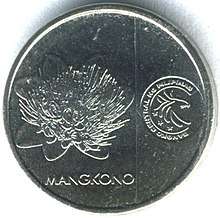 |
1 sentimo | 15 mm | 1.90 g | 1.54 mm | Nickel-plated steel | Plain | "Republika ng Pilipinas"; Three stars and the sun (stylized representation of the Philippine flag); Value; Year of minting; Mint mark | Xanthostemon verdugonianus (Mangkono); logo of the Bangko Sentral ng Pilipinas | March 26, 2018 |
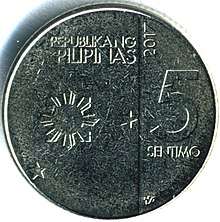 |
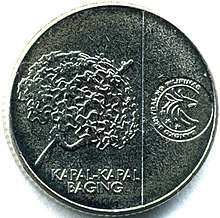 |
5 sentimo | 16 mm | 2.20 g | 1.60 mm | Nickel-plated steel | Reeded | "Republika ng Pilipinas"; Three stars and the sun (stylized representation of the Philippine flag); Value; Year of minting; Mint mark | Calotropis gigantea (Kapal-kapal Baging); logo of the Bangko Sentral ng Pilipinas | March 26, 2018 |
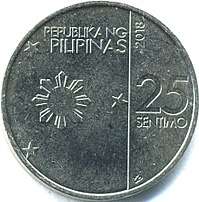 |
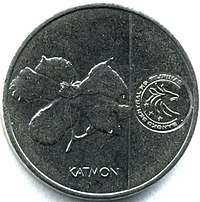 |
25 sentimo | 20 mm | 3.60 g | 1.65 mm | Nickel-plated steel | Plain | "Republika ng Pilipinas"; Three stars and the sun (stylized representation of the Philippine flag); Value; Year of minting; Mint mark | Dillenia philippinensis (Katmon); logo of the Bangko Sentral ng Pilipinas | March 26, 2018 |
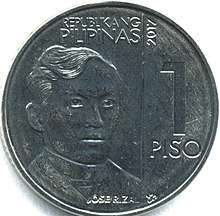 |
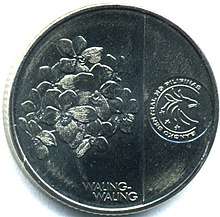 |
₱1 | 23 mm | 6.00 g | 2.05 mm | Nickel-plated steel | Segmented (Plain and Reeded edges) | "Republika ng Pilipinas"; Portrait of José Rizal; Value; Year of minting; Mint mark | Vanda sanderiana (Waling-waling); logo of the Bangko Sentral ng Pilipinas | March 26, 2018 |
 |
 |
₱5 | 25 mm | 7.40 g | 2.20 mm | Nickel-plated steel | Plain | "Republika ng Pilipinas"; Portrait of Andrés Bonifacio; Value; Microprint of "Republika ng Pilipinas"; Year of minting; Mint mark | Strongylodon macrobotrys (Tayabak); logo of the Bangko Sentral ng Pilipinas; Microprint of "Bangko Sentral ng Pilipinas" | November 30, 2017 |
_Philippines_Font.png) |
_Philippines_Back.png) |
₱5 (nonagonal shape) | 25 mm | 7.40 g | 2.20 mm | Nickel-plated steel | Plain | "Republika ng Pilipinas"; Portrait of Andrés Bonifacio; Value; Microprint of "Republika ng Pilipinas"; Year of minting; Mint mark | Strongylodon macrobotrys (Tayabak); logo of the Bangko Sentral ng Pilipinas; Microprint of "Bangko Sentral ng Pilipinas" | December 17, 2019 |
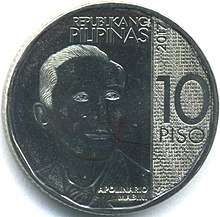 |
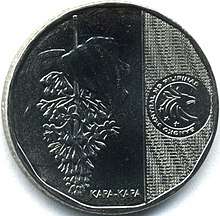 |
₱10 | 27 mm | 8.00 g | 2.05 mm | Nickel-plated steel | Reeded with edge inscription of "BANGKO SENTRAL NG PILIPINAS" in italics | "Republika ng Pilipinas"; Portrait of Apolinario Mabini; Value; Microprint of "Republika ng Pilipinas"; Year of minting; Mint mark | Medinilla magnifica (Kapa-kapa); logo of the Bangko Sentral ng Pilipinas; Microprint of "Bangko Sentral ng Pilipinas"; Microdots | March 26, 2018 |
 |
 |
₱20 | 30 mm | 11.50 g | 2.05 mm | Ring: bronze-plated steel | Plain edge with inscription of "BSP" at six angles | Ring: "Republika ng Pilipinas" | Scyphiphora (Nilad); logo of the Bangko Sentral ng Pilipinas; Malacañang Palace; Microprint of "Bangko Sentral ng Pilipinas"; Microdots | December 17, 2019 |
| Center: nickel-plated steel | Center: Portrait of Manuel Quezon; Value; Microprint of "Republika ng Pilipinas"; Year of minting; Mint mark; Microdot | |||||||||
Design
Coins
1 sentimo
The obverse side of the coin feature the description "Republika ng Pilipinas", the three stars and the sun (stylized representation of the Philippine flag), the denomination, year of minting, and mint mark, and the reverse side of the coin depicts the Xanthostemon verdugonianus (Mangkono), a plant endemic to the Philippines and the current logo of the Bangko Sentral ng Pilipinas. The composition is nickel-plated steel, has diameter of 15 mm, and mass of 1.9 grams.
5 sentimo
The obverse side of the coin feature the description "Republika ng Pilipinas", the three stars and the sun (stylized representation of the Philippine flag), the denomination, year of minting, and mint mark, and the reverse side of the coin depicts the Calotropis gigantea (Kapal-kapal baging), a plant endemic to the Philippines and the current logo of the Bangko Sentral ng Pilipinas. The composition is nickel-plated steel, has diameter of 16 mm, and mass of 2.2 grams.
25 sentimo
The obverse side of the coin feature the description "Republika ng Pilipinas", the three stars and the sun (stylized representation of the Philippine flag), the denomination, year of minting, and mint mark, and the reverse side of the coin depicts the Dillenia philippinensis (Katmon), a plant endemic to the Philippines and the current logo of the Bangko Sentral ng Pilipinas. The composition is nickel-plated steel, has diameter of 20 mm, and mass of 3.6 grams. The size and mass of this coin has same as 25 centavos in BSP Series.
1 peso
The obverse side of the coin feature the description "Republika ng Pilipinas", José Rizal, a national hero of the Philippines, the denomination, year of minting, and mint mark, and the reverse side of the coin depicts the Vanda sanderiana (Waling-Waling), a plant endemic to the Philippines and the current logo of the Bangko Sentral ng Pilipinas. The composition is nickel-plated steel, has diameter of 23 mm, and mass of 6 grams.
5 pesos
The obverse side of the coin feature the description "Republika ng Pilipinas", Andrés Bonifacio, a national hero of the Philippines, the denomination, year of minting, and mint mark, and the reverse side of the coin depicts the Strongylodon macrobotrys (Tayabak), a plant endemic to the Philippines and the current logo of the Bangko Sentral ng Pilipinas. The composition is nickel-plated steel, has diameter of 25 mm, and mass of 7.4 grams. Due to the confusion of the 5-peso coin bearing similarities with the 1-peso coin (mainly caused by its similar size), the Bangko Sentral ng Pilipinas has reissued the 5-peso coin in a nonagonal (9-sided shape) into circulation on December 17, 2019.
10 pesos
The obverse side of the coin feature the description "Republika ng Pilipinas", Apolinario Mabini, a national hero of the Philippines, the denomination, year of minting, and mint mark, and the reverse side of the coin depicts the Medinilla magnifica (Kapa-kapa), a plant endemic to the Philippines and the current logo of the Bangko Sentral ng Pilipinas. The composition is nickel-plated steel, has diameter of 27 mm, and mass of 8 grams. This is the third edge inscription coin used in the Philippines in common circulation after the 1897 one peso coin which edge is fleur-de-iles and the 50 centavo coin in 1880–1885 which is inscripted LEY PATRIA REY *** which means "Law, homeland, king".
20 pesos
The 20 peso banknote will be changed into a coin that will be released in December 2019 to solve the overuse of this banknote that only takes a year to replace it with a new banknote based on a research by the University of the Philippines. The Bangko Sentral ng Pilipinas states that the new 20 peso coin lasts for 10 to 15 years, longer than a 20 peso banknote.[12] The 20 peso coin was issued into circulation on December 17, 2019. The coin is bi-metallic, with a bronze-plated steel outer ring and a nickel-plated steel center plug, and is the second bi-metallic coin issued by the Bangko Sentral ng Pilipinas, after the 10 peso coin of the New Design/BSP series. The obverse side of the coin features a portrait of Philippine President Manuel Quezon and the reverse side of the coin depict the Scyphiphora (Nilad), Malacañang Palace, the official residence and workplace of the President of the Philippines and the current logo of the Bangko Sentral ng Pilipinas. One notable feature is the edge inscription, with the initial "BSP" at six angles. This is the fourth edge inscription coin used in the Philippines in common circulation.
Banknotes
20 pesos
Colored orange, the main design on the front of the note features a portrait of Philippine president Manuel L. Quezon along with scenes associated with Quezon, including the declaration of Filipino as the national language of the Philippines and Malacañang Palace, the official residence of the President of the Philippines. The designs on the back of the note depict the Banaue Rice Terraces, the Asian palm civet (Paradoxurus hermaphroditus), and a weave design from the Cordilleras.
50 pesos
Colored red, the main designs shown on the front of the note depict a portrait of Philippine president Sergio Osmeña and images tied to him, one depicting the First Philippine Assembly in 1907 and the other the Leyte Landing. The main designs on the back show Taal Lake, the Giant Trevally (locally known as Maliputo) (Caranx ignobilis) and an embroidery design from Batangas province.
100 pesos
Colored violet, the main designs for this denomination on the front depict a portrait of Philippine president Manuel A. Roxas and images associated with Roxas, including the founding of the Central Bank of the Philippines (Bangko Sentral ng Pilipinas) in 1949 and the Inauguration of the Third Philippine Republic on July 4, 1946. The main designs shown on the back feature the Mayon Volcano, the Whale Shark (locally known as Butanding) (Rhincodon typus) and a weave design from Bicol. The original version, issued from 2010 to 2016, included a blue underprint. Notes issued from 2016 onwards have a strong mauve or violet color, due to complaints that the color of the 100 pesos note is almost indistinguishable from the 1,000 pesos note.
200 pesos
Colored green, the main designs of the front of the note feature a portrait of Philippine president Diosdado P. Macapagal, along with images associated with Macapagal, including the EDSA People Power 2001, the Aguinaldo Shrine in Kawit, Cavite and the Barasoain Church in Malolos, Bulacan. The main designs on the back of the note feature the Chocolate Hills in Bohol, the Philippine tarsier (Tarsius syrichta), and a weave design from the Visayas. The main designs on the front of the note were used from 2010 to 2017. The 2017 issue features images showing the Declaration of Philippine Independence in Kawit, Cavite, and the Opening of the Malolos Congress in Barasoain Church, Malolos, Bulacan.
500 pesos
Colored yellow, the main designs on the front of the note feature the dual portraits of Philippine Senator Benigno Aquino Jr. and his wife, Philippine president Corazon C. Aquino. Also on the front of the note are images associated to the couple, the image of the 1986 People Power Revolution and the Benigno Aquino Jr. monument in Makati City. The main designs on the back of the note feature the Subterranean River National Park, the Blue-naped parrot (Tanygnathus lucionensis), and a cloth design from the Southern Philippines.
1,000 pesos
Colored light-blue, the main designs on the front of the note feature the trio portraits of José Abad Santos, Vicente Lim and Josefa Llanes Escoda. Also on the front of the note is an image of the Centennial celebration of Philippine independence. The main designs on the back of the note feature the Tubbataha Reefs Natural Park, the South Sea Pearl (Pinctada maxima), and a cloth design from the Mindanao design for Tinalak (Ikat-dyed abaca). The original issue from 2010 to 2017 featured the Order of Lakandula (erroneously labelled as "Medal of Honor") and its description on the front. Notes issued from 2017 onwards omit both the medal and its description.
References
- "New Generation Currency Series (2010-present)". www.bsp.gov.ph. Retrieved 2018-06-27.
- "The New Generation Currency Program of the Philippines (Bangko Sentral ng Pilipinas)". Bsp.gov.ph. 2010-03-26. Retrieved 2012-06-05.
- Cory, Ninoy together again on new 500-peso bill, Jam Sisante, GMANews.TV, December 16, 2010
- https://cnnphilippines.com/news/2016/12/20/duterte-bsp-banknotes.html
- "Still hanging on to your old peso bills? Read this". ABS-CBNnews.com. 29 December 2014. Retrieved 22 February 2015.
- BSP Releases New Generation Currency Banknotes with Enhanced Design and the Signature of the Fourth Governor of the Bangko Sentral ng Pilipinas, Bangko Sentral ng Pilipinas, December 5, 2017
- PHL peso bills to have more security features in 2020 —BSP GMA News Online (www.gmanetwork.com). July 3, 2019. Retrieved on 2019-07-03.
- Philippines – New improved banknotes MRI Bankers' Guide to Foreign Currency (mriguide.com). July 29, 2020. Retrieved on 2020-07-29.
- Bangko Sentral ng Pilipinas (www.bsp.gov.ph). Retrieved on 2020-07-29.
- Cabuenas, Jon Viktor D. (March 26, 2018). "BSP releases New Generation Currency Coins". GMA News.
- https://www.rappler.com/business/235646-bangko-sentral-pilipinas-to-create-philippine-peso-20-coin
- Bangko Sentral to create P20 coin, Rappler, July 19, 2019